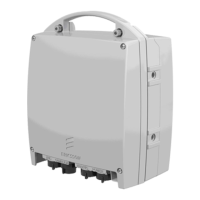MINI-LINK BAS 7-8
Technical Description EN/LZB 111 0542 P2B
7.5 FlexNU
The FlexNU uses ATM multiplexing techniques to handle properly
the traffic associated with all its ports.
Both for Ethernet and CE ports, the conversion from and into ATM
occurs within the corresponding Service Units. Therefore, the
demultiplexing of downstream traffic towards different SUs and the
multiplexing of upstream traffic from different SUs is performed at
the ATM layer.
For this purpose, the FlexNU uses a UTOPIA-like backplane, whose
capacity exceeds the aggregate throughput, which can be transmitted
and received over the radio interface.
7.6 ATM Fault Management
The MINI-LINK BAS supports the ATM fault management and
F4/F5 flows handling in the following way:
• VC-AIS cells are detected and VC-RDI OAM cells are generated
by the Ethernet port at FlexNU side according to I.610.
No notification of the VC-AIS/VC-RDI status is sent to the
management system.
• VC-AIS/VC-RDI cells are not detected or generated by the CE
ports, both at FlexNU and SNI side.
In case of VC-AIS status of the VCC an AAL1, starvation
condition occurs on the CE boards and an alarm is sent to the
management system
• VP-AIS/VP-RDI cells are handled by the system but
VP-AIS/VP-RDI status is left only when the state time-out is
expired due to missing reception of VP-AIS/VP-RDI OAM cells.
The status is not left if end-user cells are carried across the failed
VPC.
• VC-AIS cells generation is not supported by the MAC board.
• ATM loops and continuity check is not supported by the system.

